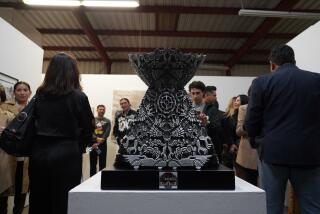Critics say Mexico bicentennial tower a monument to its failings
Reporting from Mexico City — If Mexico’s bicentennial tower knew what people were saying, it might slink off and hide (if 341 feet of stone could skulk, that is).
Since opening last month, the soaring twin slabs made of translucent quartz panels have been scrutinized, argued over and widely jeered. Some people already want to tear the monument down.
A primary source of anger is that the Estela de Luz, or Pillar of Light, was unveiled 16 months after the anniversary it was built to commemorate. By the time its lights were flipped on, the Sept. 16, 2010, bicentennial was a distant memory, and work still wasn’t done.
Added to the delays, the structure came in so far over budget that some members of Congress have called for an investigation. The original architect, Cesar Perez Becerril, has alleged official corruption and complained that his vision was ruined by design changes after he was replaced and construction was underway.
Officials defend spending about three times the projected price, saying they had to bolster the monument against earthquakes. And anyway, they insist, it’s really, really pretty.
Education Secretary Alonso Lujambio, who oversaw bicentennial events, declared the pale pillar “emblematic” of Mexican architecture and said it would be “admired by Mexicans today and in 50, 100, 200 years, because its beauty is extraordinary and because it truly symbolizes a historic moment for Mexico.” Lujambio took leave last month, citing illness.
Nonetheless, many Mexicans can’t get past the price tag of about $79 million.
“It could have been used elsewhere on things we need, like public safety,” said nurse Alicia Hernandez, who stopped to survey the monument on a recent morning. “It was a bad investment.”
The pillar has become a handy target for critics of President Felipe Calderon, who said it would be a “source of pride and unity” in time for the bicentennial celebration. Talk about blowing a deadline.
Calderon foes called for protests at the foot of the monument on the day of its scheduled Jan. 8 unveiling. The government countered by suddenly switching the event to the day before, summoning reporters barely an hour before the lighting ceremony.
As with public art anywhere, everyone has an opinion on how it looks. From a distance, the pillar might be mistaken for a towering solar panel. To some, its waffled appearance brings to mind a popular wafer cookie sold here, the Suavicrema.
At night, the monument’s golden glow is eye-catching. But by day, with the lights off, it is less spectacular. Location doesn’t help: The column stands near a skyscraper known as the Torre Mayor, the tallest in Mexico, and ends up looking more spindly than splendid.
Social networking sites have sizzled with put-downs: The pillar should be made a monument to corruption; a gigantic console for playing Tetris; a countdown clock marking the days left in Calderon’s term.
Noted art critic Raquel Tibol labeled the monument “horrible,” saying that if it can’t be removed, it should be turned into a “vertical garden.”
Jose Padilla, 50, who sells newspapers from a stand beneath the monument, gestured in disgust, saying the 1,700 quartz plates weren’t even a uniform shade of dirty white. He then launched into how it reflected everything wrong with Mexico: corruption, lack of accountability, the failure to punish officials for misdeeds and bad decisions.
“It was supposed to be for the bicentennial and it opens now?” Padilla said. “It’s a mockery.”
The monument’s twin columns were meant to represent two centuries of Mexican independence. Its height in meters — 104 — is a multiple of 52, a number its sponsors said was key to Mexico’s pre-Hispanic dwellers. The side panels were meant to emit light and reflect it.
One thing is clear: The Pillar of Light has a long way to go to be considered in the same class as the Angel of Independence, erected in 1910 to mark Mexico’s first 100 years. Unlike the bicentennial tower, the earlier monument was enthusiastically received at the time. (It also happened to be completed on time.)
That elevated monument, with a 118-foot Corinthian column topped by a gilded winged angel, is a frequent site of celebrations and protests on the majestic Paseo de la Reforma. The angel image is used as a symbol of Mexico City.
“The angel represents the culture, the traditions of society,” said Hugo Enrique Montecillo Lara, an architect visiting from the central state of Guanajuato.
He gazed up at the Pillar of Light and frowned. “This represents nothing.”
More to Read
Sign up for Essential California
The most important California stories and recommendations in your inbox every morning.
You may occasionally receive promotional content from the Los Angeles Times.










